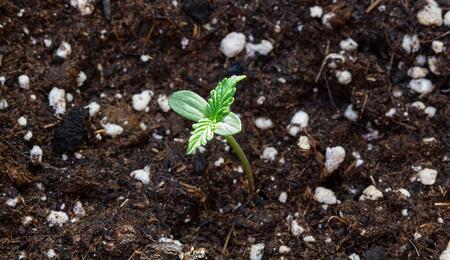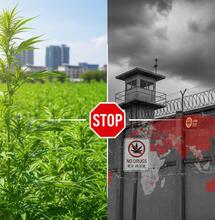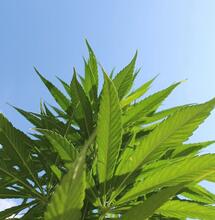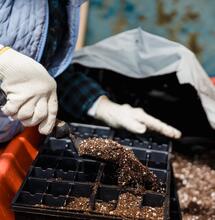The Different Stages of the Growth Process

Growing Cannabis consists of several different stages, each demanding unique treatment and pampering about water, nutrients, light, temperature, and humidity. Depending on the strain you are cultivating and how you grow, the growth process will complete anywhere within four to eight months. In indoor settings, where as a grower you have the ultimate control of all environment factors, Cannabis plants can flower much quicker than outdoors. Below we lay out key information on each stage of the indoor growing process of Cannabis.
Timeline for growing Cannabis:
- Germinating: 1-7 days
- Seedling: 2-3 weeks
- Vegetative stage: 2-8 weeks
- Pre-Flower period: 1-2 weeks
- Flowering stage: 6-8 weeks
- Harvest
Germination
There are different methods for germinating a cannabis seed. Germination can be done using a paper towel, a glass of water, or planting directly in the soil. The seed is expected to pop out a small white tail within 48-72 hours. At this very early stage, all you have to give them is plain water with minimal nutrients. If you are new to growing, it is best to use feminized seeds. There is much better choice than with regular seeds, and it also means you won't have to remove male plants from the garden later on. If you are seeding directly in the soil, make sure it's good-quality soil.
Seedlings
Temperature is the first thing to consider when deciding where to place your seedlings. You're aiming for a temperature between 71 to 79 degrees Fahrenheit. The room should remain warm after the lights go off as well. If possible, grow the sprouting seeds under fluorescent lights until they surpass four inches. After reaching this height, most seedlings begin to behave as mature plants. The central stalk grows wider and the leaves start to grow significantly by the day. Light exposure should remain 16 hours on and 8 hours off for seedlings.
Avoid adding micronutrients such as iron, boron, or manganese in the first several weeks because it will cause the oldest leaves to die at the ends of the leaf. The seed is already packed with all the trace elements the seedling needs at this initial stage of growth.
Vegetative stage
Things get more demanding during the vegetative phase or after relocating the plant to a larger container where you ensure it has enough space to spread its roots and grow. The stem becomes thicker and grows taller, and the foliage also develops during this period. Many growers opt to top and train their crops during the vegetative stage to maximize the yield later on.
During vegetation, you can already distinguish whether you are growing a Sativa or Indica strain. Sativas are thinner and taller and don't have as many leaves. Indicas are shorter, denser, and bushier. The vegetative stage demands more water intake, macronutrients such as Nitrogen and Potassium, as well as increased room humidity. Indoor plants should be exposed to 18 hours of light with 6 hours off. You can also opt for a 24-hour light regiment, however, some plants may actually benefit from a break in the light cycle.
Plants need to remain in well-drained soil at all times. Overwatering may cause more severe issues than underwatering. It's better to water at certain time intervals and farther away from the stalk so that the tips of the roots can easily absorb the water.

Pre-Flower period
It takes almost two weeks for a plant to enter the pre-flowering period. When it does, you can quickly tell the sex of your plant by looking at the pre-flowers found at the nodes. Females will grow with two pistils, the part containing the flower's reproductive parts. Males on the other hand will have tiny green sacs filled with pollen, also seen around the node areas. When the sacs on a male or intersex plant burst, the pollen can fertilize the cola of nearby females, which would ruin the psychoactive content of the trichomes. That is why removing male or "herming" plants from the garden is critical.
Vigorous female plants will typically form one central cola surrounded with smaller colas going outward of the plant. Low-stress training in the vegetation stage can bump up the number of colas. Once light exposure to the plant is switched from 18 to 12 hours a day, the flowering process starts.
Flowering
With 12 hours of darkness, Cannabis plants undergo a chemical change that dictates the production of flowers. Around this period, the plants will stretch upward and grow more than double their initial height. It is important to note that once the light regime is changed to 12/12, it is not recommended to switch back to 18/6 as this may cause stunted growth.
During flowering, Cannabis plants need increased amounts of Phosphorus and Potassium. Most liquid nutrient solutions designed for the vegetative phase will contain more substantial ratio of Nitrogen and less Phosphorus and Potassium. Some growers prefer feeding a high Nitrogen liquid feed in the first two weeks of the 12/12 light regime. After three weeks, the Cannabis plants will have fully stretched, so this is when you must switch to solutions higher in P and K.
The temperature should remain warm during flowering. Around 75 degrees Fahrenheit will do in most cases. However, humidity should be gradually reduced to the lower benchmarks, between 40% and 30%. The dry environment will stimulate plants to produce more resin and grow tighter buds. Lower humidity also protects cannabis plants from pathogens such as mold and powdery mildew, which you really don't want to deal with at this stage of the growth process.

Harvesting
It is essential not to let the cannabis plants grow for too long, otherwise there is the danger of harvesting weed with low amounts of THC. Looking at the stigma and trichomes can help determine if your cannabis plants are ripe and ready to harvest both indoors and outdoors. The stigma is the hair-like strands that enclose the buds. When it's time to harvest, it will turn from white to orange and it begins to curl. Trichomes, the resinous glands all over the plant, will color shift from transparent to opaque and then amber.
Amber and brownish tones indicate that more THC has degraded, in which case the yield will be calmer and more stoney. So, if you are looking for a more energetic high, ensure there are enough white, milky trichomes before harvesting.
It may be tricky with the top colas, which will probably reach maturity faster than lower-positioned fruits. That is because the top part of the plant is usually exposed to more light than the rest. But the harvest will have to begin even though some buds are ripe and others are not quite there yet. A rough estimate of when a strain should be harvested can also be obtained from the breeder or seed provider.
The harvested plant material needs to be cut into smaller branches to ease the drying process that follows. The cuttings should be strung and hung upside down in a cool, dark room. The average drying period is around ten days, and the preferred humidity level is in the 40-50% range. Drying is necessary to ensure fungus and bacteria don't spread on the plant matter.
The very last step would be curing, which involves storing the weed in sealed airtight containers such as mason jars and placing them in a cabinet with a temperature average of around 55 degrees Fahrenheit. The jars can stay like that for between one and three weeks and should be opened briefly once a day to release accumulated gases while absorbing fresh air. Curing is an optional step, but it can significantly reduce the harshness of weed, all while improving the buds flavor and burn quality.
Happy growing!












